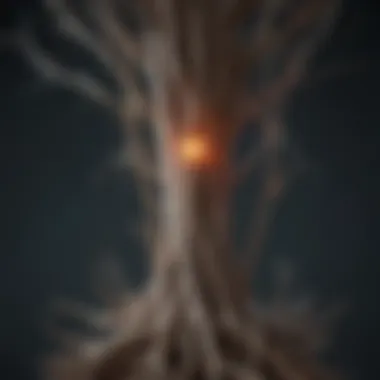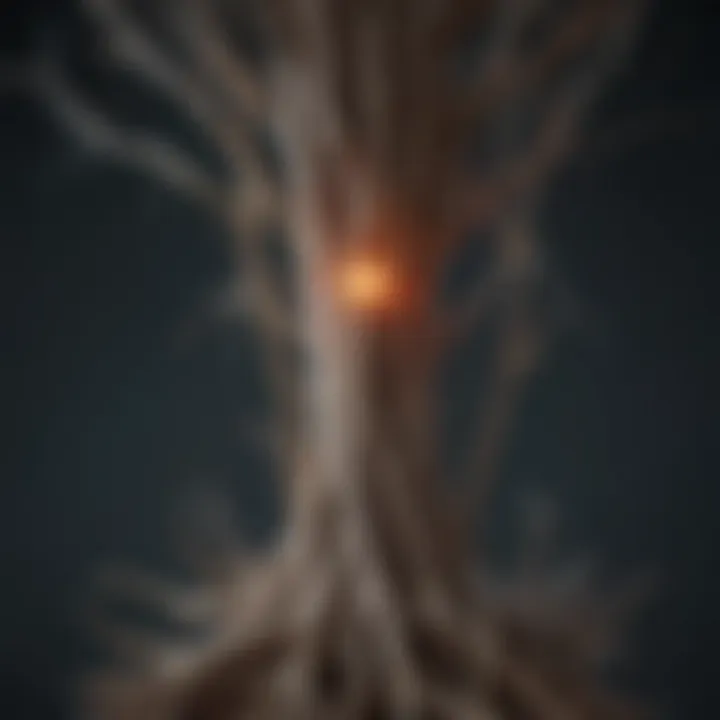Direct Visualized Rhizotomy: Techniques and Outcomes


Intro
Direct visualized rhizotomy is a pivotal surgical procedure primarily employed in the realm of pain management. This technique is characterized by its focus on specific nerve roots, aiming to alleviate chronic pain that often arises from various underlying conditions. In recent years, a remarkable evolution in surgical techniques has emerged, turning the spotlight on innovations that improve visualization, ease of operation, and patient recovery.
The discussion surrounding direct visualized rhizotomy is not merely academic; it resonates with the lived experiences of patients who seek relief from incapacitating discomfort. Considering the changing landscape of neurosurgery, it becomes essential to explore the methodology, associated risks, and potential benefits intrinsic to this procedure.
Clinical professionals, scholars, and medical students will find interest in understanding not only how this technique operates but also the broader implications it holds for surgical practices and patient care.
Article Overview
Summary of Key Findings
Direct visualized rhizotomy stands as a landmark advancement in surgical interventions for pain relief. Several studies have noted that the precision with which nerve roots can be targeted greatly enhances patient outcomes. The key findings include:
- Improved Surgical Outcomes: Increased accuracy in targeting the affected nerves leads to more effective pain management.
- Reduced Recovery Time: Patients commonly experience shorter hospital stays and quicker recoveries after the procedure.
- Technological Advancements: Innovations in imaging and minimally invasive techniques have transformed the procedural landscape, resulting in less trauma to the patient.
Research Objectives
The primary objectives of this exploration are:
- Understanding Methodology: Delve deeply into the procedures involved in direct visualized rhizotomy.
- Assessing Effectiveness: Compare its outcomes against traditional surgical methods for pain relief.
- Examining Risks vs. Benefits: Offer a balanced view of potential complications alongside the advantages it brings.
In synthesizing the findings presented in this article, we aim to foster a clearer understanding of how direct visualized rhizotomy fits into the larger framework of pain management and surgical techniques. This holistic approach not only elucidates the operational aspects but acknowledges the innovative spirit that underpins advancements in the medical field.
Key Results and Discussions
Main Findings
The findings reveal a spectrum of benefits linked to the adoption of direct visualized rhizotomy in clinical practice. Patients often report:
- Significant Pain Reduction: Many patients demonstrate notable decreases in pain scores post-surgery.
- Higher Satisfaction Rates: A higher rate of patient satisfaction is recorded in follow-up assessments.
These outcomes contribute to a growing body of evidence that supports the essential role of direct visualized rhizotomy in contemporary surgical practice.
Implications of Findings
The implications for practice are profound. Medical professionals now have a reliable surgical option that aligns closely with patient-centric care models. As surgical precision and patient satisfaction continue to be focal points in healthcare, the integration of techniques like direct visualized rhizotomy paves the way for improved standards in both surgical education and patient management.
Moreover, these advancements contribute to a paradigm shift toward more minimally invasive surgical approaches, minimizing the physical and psychological burden on patients. Therefore, fostering a dialogue around technological enhancements remains crucial for the continuous advancement of neurosurgical practices.
Prelims to Direct Visualized Rhizotomy
Direct Visualized Rhizotomy is a rapidly evolving technique that offers new possibilities in the field of pain management. This surgical approach primarily addresses chronic pain by specifically targeting nerve roots involved in transmitting pain signals. As the demand for effective pain relief grows, understanding the ins and outs of this procedure becomes paramount not only for medical professionals but also for researchers and students immersed in health sciences.
One of the core elements of this technique involves precision in locating and severing problematic nerve pathways. This is crucial; ineffective pain management strategies can lead to a decreased quality of life. When discussing the benefits of Direct Visualized Rhizotomy, it’s essential to appreciate its minimally invasive nature that aligns with modern surgical trends. By minimizing trauma while maximizing outcomes, this method is also appealing to patients who often lean towards options that promise quicker recoveries and less postoperative discomfort.
Definition and Overview
Direct Visualized Rhizotomy refers to a surgical procedure that, through direct observation, disrupts the nerve roots operating in areas responsible for pain perception. Essentially, it provides surgeons with a clear view of the applicable anatomy intersecting during the procedure, making it a distinct and essential technique within the realm of neurosurgery. This enhanced visualization transforms conventional rhizotomy methods, integrating advanced technologies that enhance precision.
Historical Context
The roots of rhizotomy can be traced back many decades, but it was not until the advent of modern imaging techniques like MRI and CT scans that the surgical practice received a considerable facelift. Pioneers in the field began developing more targeted approaches that eventually led to the creation of direct visualized rhizotomy as we know it today. By understanding the historical backdrop, one can appreciate the journey of surgical interventions evolving from rudimentary techniques to sophisticated, nuanced practices. This evolution reflects a broader trend in medicine where technology increasingly intersects with surgical methodologies for better patient outcomes.
Significance in Pain Management
The significance of Direct Visualized Rhizotomy in the domain of pain management cannot be overstated. Chronic pain conditions, such as those stemming from herniated discs or arthritis, often present a significant burden to patients. Traditional pain management strategies, including medication and physical therapy, are not always sufficient. Here, Direct Visualized Rhizotomy serves a vital role – it essentially interrupts the pain signaling pathways at their source.
Furthermore, the ability to perform this procedure with enhanced visualization minimizes surgical risks, providing a safety net through better anatomical understanding. As a result, many patients experience marked improvements in their pain levels, highlighting the critical bridge this procedure forms between technology, surgical intervention, and effective pain relief for individuals suffering from debilitating chronic pain.
Anatomical Considerations
Understanding the anatomy of nerve roots is crucial in the realm of direct visualized rhizotomy. This surgical technique is highly dependent on precise knowledge of the spinal structure, particularly the location and function of nerve roots. The significance of anatomical considerations cannot be overstated; they play a direct role in planning and executing the rhizotomy procedure, aiming to alleviate chronic pain with minimal risks to surrounding tissues.
Understanding Nerve Roots
Nerve roots are the initial segments of spinal nerves and form a pivotal connection between the central nervous system and the peripheral nervous system. Each nerve root branches out to innervate specific body areas, effectively making them the messengers for various sensations, including pain. In direct visualized rhizotomy, the fundamental goal is to selectively target these roots that are involved in pain transmission without damaging adjacent structures.


When assessing nerve roots, it is important to recognize their anatomy:
- Dorsal Roots: These carry sensory signals from the body to the spinal cord. Damage to these roots can lead to loss of sensation or altered pain perception.
- Ventral Roots: Contrarily, these roots send motor signals from the spinal cord to the muscles, playing a vital role in movement.
- Spinal Ganglia: Located at each dorsal root, these structures contain the cell bodies of sensory neurons, further emphasizing their role in pain pathways.
Understanding these components and their relationships is essential for surgeons undertaking rhizotomy. If not navigated cautiously, missteps in targeting could result in unintended consequences, such as motor losses or chronic pain in other areas.
Role of Rhizotomy in Pain Pathways
The intricate web of pain pathways highlights the importance of anatomical considerations in rhizotomy. Pain signals travel from peripheral tissues, through the nerve roots, into the spinal cord, and finally up to the brain. When certain environmental factors or injuries disrupt this pathway, chronic pain ensues.
Rhizotomy directly disrupts these pathways by targeting specific nerve roots responsible for carrying the pain signals. The surgical intervention focuses on:
- Interrupting Pain Signals: By severing or damaging the targeted nerve roots, the transmission of pain signals is interrupted, potentially leading to significant relief for patients suffering from chronic pain syndromes.
- Reducing Inflammation: With the nerve's connections severed, inflammation in the nerves can decrease, contributing to pain reduction.
"Effective management of pain hinges on understanding the very pathways by which pain travels. The anatomy is integral not just to the profession but also to optimizing patient outcomes."
Technique of Direct Visualized Rhizotomy
The technique of direct visualized rhizotomy stands as a critical component in managing chronic pain. Gaining a clear understanding of the procedural nuances is vital for both practitioners and patients alike. This segment dives into the preparation, execution, and postoperative considerations that underscore the procedure's efficiency and safety in alleviating discomfort.
Preparation and Considerations
Preparation for direct visualized rhizotomy begins with thorough patient evaluation. This includes understanding the specific pain characteristics, diagnostic imaging, and a detailed medical history. Before the procedure, informed consent is paramount. Patients need to grasp not just the benefits, but the potential risks as well. The team must ensure that the patient is in optimal condition for surgery, factoring in overall health and any co-existing medical concerns. The emphasis here is on a collaborative atmosphere, where concerns are addressed, and expectations are set clearly.
Surgical Procedure Steps
Anesthesia Requirements
Anesthesia plays a pivotal role in ensuring the comfort of the patient during the rhizotomy. The choice of local versus general anesthesia hinges on the individual case; local anesthesia often proves advantageous due to shorter recovery times and fewer complications related to sedation. The primary goal is to achieve a pain-free state while preserving the patient's ability to communicate during the procedure, allowing surgeons to receive feedback on any discomfort.
Visual Intrusion Techniques
Visual intrusion refers to the methods employed to enhance surgical visualization. Advanced imaging technologies, such as fluoroscopy or ultrasound guidance, ensure that the surgical team can navigate effectively to the targeted nerve roots. This direct visual approach significantly reduces the risk of damaging adjacent tissues, making it a favored strategy among neurosurgeons. Such precision can markedly improve the overall outcome, as it allows for a more tailored intervention.
Nerve Mobilization
Nerve mobilization is essential during the procedure to expose the targeted nerve roots adequately. This step highlights the adaptability of the nerve structures, allowing them to be maneuvered into a better position without causing undue tension. The importance of this technique cannot be overstated; effective mobilization ensures that surgeons can operate with greater accuracy, reducing the chances of complications post-surgery. Here, one can appreciate the meticulous nature of both the planning and execution stages of direct visualized rhizotomy.
Postoperative Care
Following the procedure, diligent postoperative care ensures a smooth recovery. Monitoring recovery involves observing the patient for any immediate effects of surgery, including assessing pain levels and neurological function. This care phase is as much about reassurance as it is about clinical observation.
Monitoring Recovery
Effective monitoring is a hallmark of postoperative care. It involves frequent assessments of the patient's vitals and neurological status. By implementing structured protocols, healthcare teams can quickly identify and manage potential complications. This vigilant approach enhances patient safety and lays the groundwork for a successful recovery trajectory.
Managing Complications
Managing any complications that arise is crucial. This could range from unexpected pain emergence to infections. Addressing these issues promptly can make a significant difference in recovery outcomes. Strategies here might include regular assessments, patient education on symptoms to watch for, and quick intervention when complications are detected. By focusing on adaptive recovery strategies, healthcare teams aim to minimize disruptions and enhance overall patient satisfaction with the surgical experience.
"Surgical success isn't merely about technical execution but also how well we care for patients before, during, and after the procedure."
In summary, mastering the technique of direct visualized rhizotomy encompasses a myriad of preparatory and procedural elements that are essential for achieving the desired outcomes. The collaborative efforts between surgical teams and the patients they serve ultimately define the success of this sophisticated approach to pain management.
Indications for Direct Visualized Rhizotomy
Understanding the indications for direct visualized rhizotomy is crucial in ensuring the procedure is carried out effectively and benefits those who truly need it. As a surgical approach tailored for chronic pain, this technique is selective in its application. Knowing which types of chronic pain conditions respond best to this intervention not only aids in patient outcomes but also helps in optimizing healthcare resources.
The decision to employ direct visualized rhizotomy rests on multiple factors, including the patient's medical history, pain characteristics, and their response to previous treatments. Consequently, establishing clear indications is not merely beneficial; it’s essential in advancing the field of pain management.
Types of Chronic Pain Treated
Direct visualized rhizotomy is particularly useful for several major types of chronic pain. Some of these conditions include:
- Cervical and Lumbar Radicular Pain: Often arising from herniated disks or spinal stenosis, patients experience sharp or burning sensations radiating down the limbs, which can greatly affect quality of life.
- Postherpetic Neuralgia: This pain follows an episode of shingles, manifesting as persistent nerve pain that can be debilitating.
- Complex Regional Pain Syndrome (CRPS): A condition characterized by severe, often relentless pain typically affecting limbs, which may not respond well to traditional pain management techniques.
- Facet Joint Pain: Involves inflammation or irritation of spinal facet joints, leading to localized or radiating pain.
- Cancer-Related Pain: This may stem from direct tumor involvement or as a consequence of treatments like chemotherapy and radiation, warranting targeted interventions to manage the pain.
The choice of direct visualized rhizotomy for these types of chronic pain stems from its targeted nature, aiming at specific nerve branches that contribute significantly to the pain experienced by the patient.


Patient Selection Criteria
When it comes to patient selection, several key criteria must be considered to ensure optimal outcomes from direct visualized rhizotomy. The following elements play a crucial role in determining whether a patient is a suitable candidate:
- Diagnosis Confirmation: Prior imaging studies, such as MRI or CT scans, might be necessary to validate the diagnosis of chronic pain and ensure that interventions directly target the relevant nerve roots.
- Duration of Pain: Patients are typically evaluated based on the chronic nature of their pain, where symptoms have persisted for an extended period, ideally beyond three months.
- Response to Conservative Treatments: Candidates usually will have undergone less invasive treatments, such as physical therapy, medication management, or nerve blocks, without significant improvement.
- Psychological Readiness: Psychological assessments may be warranted to gauge patient understanding of the procedure, potential benefits, and side effects, ensuring informed consent.
- Age and Health Status: General health and age can also influence the decision, as older adults or those with comorbidities might face increased surgical risks.
Incorporating these critical selection criteria narrows down candidates who are likely to benefit most from direct visualized rhizotomy, ensuring that the risks are outweighed by the potential for improved quality of life.
Outcomes of Direct Visualized Rhizotomy
The outcomes of direct visualized rhizotomy are pivotal in evaluating its overall efficacy as a treatment option for chronic pain. This section aims to analyze how this surgical technique not only alleviates pain but also influences the quality of life for patients post-procedure. By examining effectiveness in pain relief and the subsequent quality of life improvements, a clearer picture emerges regarding the benefits and long-term implications of the technique.
Effectiveness in Pain Relief
The primary goal of direct visualized rhizotomy is to provide substantial relief from chronic pain, particularly for those patients who have not found success with conventional therapies. The technique specifically targets sensory nerve roots, which are often at the core of chronic pain syndromes.
Research consistently shows that patients undergoing this procedure experience significant reductions in pain intensity. In many cases, effectiveness is measured through various pain scales, allowing for standardized assessment methods. Post-operative evaluations frequently show an average reduction in pain scores from severe to moderate, or even mild.
Highlighting statistical data, studies reveal that around 70-80% of patients report substantial pain relief six months after surgery. This translates into an overall satisfaction rate that reflects the procedure's impact on pain management. The precision afforded by direct visualization aids in minimizing damage to surrounding neural structures, which can otherwise exacerbate pain conditions.
Quality of Life Post-Surgery
Quality of life is a crucial aspect of any medical intervention, and for patients suffering from chronic pain, this factor often determines the perceived success of a surgical procedure.
Patient Satisfaction Rates
Patient satisfaction rates serve as a direct testament to the effectiveness of direct visualized rhizotomy in enhancing overall well-being. Often, the metric is gauged through surveys post-surgery, where individuals express their contentment or discontent concerning pain relief and improvements in daily activities.
The key characteristic of patient satisfaction rates lies in their correlation to functional capability post-operatively. Many patients report higher rates of satisfaction because they experience a renewed ability to engage in activities they once found challenging. This aspect encompasses not just pain relief, but also emotional well-being, as regaining independence contributes significantly to patient morale.
However, one unique feature here is the variability in individual responses; while many patients thrive, others may have fluctuating outcomes depending on their specific health conditions, pain durations, or psychological factors. This range of satisfaction indicates that while direct visualized rhizotomy presents a potentially beneficial option, it is not a cure-all for everyone facing chronic pain.
Functional Improvement
Functional improvement post-surgery is another critical piece in the puzzle of evaluating outcomes. This aspect emphasizes the day-to-day capabilities of patients, especially those whose chronic pain limited their activities significantly prior to surgery.
Highlighting the functional characteristic of improved mobility or engagement in daily activities post-surgery is critical. Many patients often recount stories of being able to return to work, manage household tasks, or participate in social activities without the looming shadow of pain holding them back. The uniqueness of functional improvement lies in the qualitative changes it brings, showcasing that beyond pain relief, patients gain a new lease on life.
However, the disadvantages lie in the potential for post-surgical complications, which can dampen improvement rates. Some patients may face persistent discomfort or functional decline if complications arise, emphasizing the need for appropriate patient selection and pre-operative counseling.
Risks and Complications
Understanding the risks and complications associated with direct visualized rhizotomy is crucial not only for surgical teams but also for patients considering this authoritative procedure. While this technique has gained recognition for its effectiveness in managing certain chronic pain conditions, it is not without potential drawbacks. An open dialogue about these risks ensures that patients make fully informed decisions and highlights the importance of preoperative discussions.
Common Surgical Risks
Surgical procedures, regardless of their precision, carry inherent risks. When considering direct visualized rhizotomy, common surgical risks may include:
- Infection: Postoperative infections can happen at the surgical site, sometimes leading to a need for further interventions.
- Hemorrhage: While the procedure aims to target specific areas, there’s always a possibility of excessive bleeding if vital blood vessels get unintentionally harmed.
- Nerve Damage: Although the procedure focuses on nerve roots, there's a chance of impacting surrounding nerves, which can result in unintended neurological deficits.
- Anesthetic Complications: Reactions to anesthesia, though rare, can pose severe risks if not adequately managed.
These risks should be communicated clearly to patients, allowing them to weigh the positives against potential negatives before opting for surgery. Transparency in the surgical process fosters trust and can help patients feel more at ease, appreciating the complexity of the decision they are making.
Long-Term Effects
Beyond the immediate surgical complications, long-term effects warrant careful consideration. Patients might experience outcomes that can influence their quality of life significantly. Some of these effects include:
- Persistent Pain: While the goal is to alleviate pain, there remains a risk that patients may not achieve the desired level of pain relief and could continue to experience discomfort post-surgery.
- Changes in Sensation: Issues such as numbness or altered sensation in the limb may occur. These changes depend on the individual patient’s anatomy and the specifics of the surgical technique employed.
- Psycho-emotional Impact: Long-term pain management issues can affect a person’s mental well-being. Patients may experience anxiety or depression, affecting their recovery journey, making psychological support essential.
- Need for Additional Procedures: In some cases, those undergoing direct visualized rhizotomy might find themselves in need of further surgeries down the line, either due to insufficient pain relief or newly developed complications.
It's essential for practitioners to prepare patients adequately for these long-term considerations, fostering realistic expectations about outcomes and recovery paths.
Comparison with Traditional Rhizotomy Techniques
In the arena of pain management, understanding the differences between direct visualized rhizotomy and traditional rhizotomy techniques is pivotal. This comparison highlights not just the evolution of surgical approaches but also their direct impact on patient outcomes and overall therapeutic efficacy. Traditional rhizotomy methods have served their purpose for years, but as technology advances, so do the standards and expectations surrounding these procedures.
Advantages of Direct Visualization
Direct visualization during surgical procedures brings a treasure trove of benefits that older techniques lack. Here are some notable advantages:


- Precision: Surgeons can visualize the target nerve root directly, minimizing damage to surrounding tissues. This accuracy is akin to hitting a bullseye with a dart, vastly improving the precision of the intervention.
- Reduced Trauma: By employing enhanced imaging techniques, direct visualized rhizotomy reduces the risk of unnecessary trauma. It’s more like using a scalpel instead of a sledgehammer; you get the work done without the collateral damage.
- Tailored Approaches: A visualized method allows surgeons to adapt their techniques in real-time, making adjustments as they navigate the intricacies of the human anatomy.
- Enhanced Recovery: Patients typically experience quicker recovery times due to the less invasive nature of the procedure. With reduced healing time, patients can return to their daily activities faster than may have been possible with traditional methods.
"Patient success is not just about alleviating pain; it’s about improving quality of life. Direct visualization reshapes this journey significantly."
Limitations of Conventional Methods
While traditional rhizotomy methods have laid down the groundwork in pain management, they come with their own set of limitations that cannot be overlooked:
- Limited Visualization: Older techniques often rely on less accurate imaging, which can lead to misidentification of nerve roots. It’s like trying to assemble furniture without the manual – it may work out, but chances are you’ll have a few extra screws left over!
- Higher Risk of Complications: Conventional methods can inadvertently affect nearby nerves or structures, causing complications that directly impact recovery and success rates. The margin for error is larger, often leaving patient outcomes in the balance.
- Longer Recovery Period: Due to greater incisions or trauma inflicted during surgery, patients often face longer recovery times, which compounds their initial pain issues with post-surgical discomfort.
- Standardized Techniques: Unlike the flexibility offered by direct visualization, conventional methods often employ a one-size-fits-all approach, which might not be effective for every patient’s unique anatomy.
In summation, while traditional rhizotomy techniques have provided valuable contributions to pain management, their limitations are evident in the light of more modern, direct visualized approaches that pave the way for more customized and effective treatments.
Technological Advancements in Visualized Techniques
Technological advancements have significantly impacted surgical practices, specifically in the realm of direct visualized rhizotomy. These innovations aim to enhance precision, augment safety, and improve patient outcomes. In this section, we will delve into two major components of these advancements: imaging technologies and minimally invasive approaches.
Imaging Technologies
Imaging technologies play a pivotal role in the performance of direct visualized rhizotomy. Techniques such as MRI, CT scans, and ultrasound provide neurosurgeons with detailed views of nerve roots and the surrounding anatomical structures. This clear visualization helps the surgeon identify the exact location of the target nerve, minimizing the risk of damaging adjacent tissues or nerves.
- MRI (Magnetic Resonance Imaging): This technique uses strong magnets and radio waves to generate detailed images of the soft tissues in the body. In pre-operative planning, MRI can reveal pathology impacting nerve roots, allowing for customized surgical approaches.
- CT Scans: Computed Tomography employs X-rays to create cross-sectional images of the body, delivering a more comprehensive view of skeletal structures and any possible abnormalities in the spine.
- Ultrasound: Utilizing high-frequency sound waves, ultrasound provides real-time imaging during the procedure. This helps surgeons assess the anatomy as they operate, ensuring accuracy in targeting specific nerve roots.
By leveraging these imaging technologies, surgeons can navigate through complex anatomical structures with greater confidence. Often, these modalities come together to provide a fuller understanding of each unique case.
Minimally Invasive Approaches
Next on our discussion is the emergence of minimally invasive approaches in direct visualized rhizotomy. Unlike traditional surgical methods that require extensive incisions, these modern techniques allow for smaller openings, significantly reducing trauma to the body.
The advantages of minimally invasive rhizotomy include:
- Reduced Recovery Time: Patients experience shorter hospital stays and quicker returns to daily activities due to the decreased physical stress imposed by smaller surgical wounds.
- Lower Rates of Complications: With less extensive surgery, there’s typically a lower chance of infection or other complications that can arise from larger incisions.
- Less Scarring: Minimally invasive procedures lead to smaller scars, which may be a concern for many patients who prioritize aesthetics.
Moreover, surgeons can utilize enhanced visualization technologies alongside these techniques, enabling them to conduct procedures through very narrow fields while maintaining high precision. This combination not only improves patient safety and outcomes but also boosts overall satisfaction post-surgery.
In summary, the incorporation of advanced imaging technologies and minimally invasive techniques has revolutionized direct visualized rhizotomy, positioning it as a more effective option in contemporary pain management strategies. As research progresses and technology continues to evolve, the potential for improved methods in this field only grows.
Future Directions and Research
Exploring future directions and research in direct visualized rhizotomy is crucial as the landscape of pain management continually evolves. This section dives into the emerging techniques potential and how they might be applied to benefit patient care. Keeping an eye on future developments not only serves to enhance current methodologies but also signals a shift towards innovative, tailored approaches to treatment that align with a patient's unique needs.
Emerging Techniques
As research progresses, multiple innovative techniques are surfacing that promise to refine direct visualized rhizotomy even further. One key development is the integration of robotic assistance in the surgical procedure. Robotic technology can offer enhanced precision during delicate interventions, minimizing the potential for nerve damage and improving outcomes. Moreover, the incorporation of augmented reality (AR) into surgical practice is gaining traction. Surgeons can visualize important anatomical landmarks superimposed on their field of view, leading to more accurate incisions and ultimately safer surgery.
Furthermore, regenerative medicine techniques, such as stem cell therapy, are being explored in conjunction with direct visualized rhizotomy. By repairing or regenerating damaged nerve tissue, these strategies could reduce the recurrence of pain, which would be a game changer for patients who often face chronic conditions.
"The realm of neurosurgery is on the cusp of revolutionary changes that could redefine pain management."
Potential for Broader Applications
The future applications of direct visualized rhizotomy extend beyond its current use for chronic pain management. For instance, research is indicating a potential role in treating neuropathic pain conditions, which frequently prove resistant to standard treatments. Conditions like complex regional pain syndrome, diabetic neuropathy, and post-surgical pain syndromes might all benefit from targeted rhizotomy techniques. This shift towards addressing more diverse pain types emphasizes the procedure's versatility and the importance of ongoing research.
Additionally, with continued advancements in imaging technologies, the precision of rhizotomy could enhance treatment not just for pain, but also for various neurological disorders where nerve root involvement plays a crucial role. Conditions like migraines and other headache disorders have complex neuroanatomy that could potentially be addressed through specialized applications of this surgical technique.
Understanding these broader applications could spark interdisciplinary collaborations between neurosurgeons and specialists in pain management, paving the way for comprehensive treatment protocols and improving overall patient outcomes. The potential implications of these advancements offer a promising horizon in the management of chronic pain and beyond.
End
In the realm of pain management, the practices and techniques employed continue to evolve. Direct visualized rhizotomy stands as a testament to the strides made in surgical innovation and its applicable effectiveness in addressing chronic pain. This conclusion synthesizes the crucial points discussed throughout the article and examines the lasting implications for medical practice.
Summation of Key Points
To encapsulate the essence of what has been detailed, several key elements emerge:
- Definition and Significance: Direct visualized rhizotomy is not just another surgical technique; it is a targeted approach that directly addresses the root of chronic pain.
- Anatomical Insights: Understanding the anatomy of the nerve roots is critical. This knowledge informs the surgical process and enhances both the precision and safety of the procedure.
- Technique and Procedure: The surgical steps, from preparation through postoperative care, highlight the procedural nuances that lead to enhanced outcomes.
- Risks and Benefits: While risks are inherent, the balance of effectiveness in pain relief against potential complications is a significant area of focus.
- Technological Advances: Modern imaging technologies allow for better visualization, enhancing the surgeon’s ability to conduct the procedure with less trauma and improved outcomes.
- Future Directions: Ongoing research into emerging techniques shows promise for broader applications of direct visualized rhizotomy in pain management.
Implications for Practice
The implications of direct visualized rhizotomy for clinical practice are substantial. Surgeons and pain management specialists are encouraged to:
- Adopt Evidence-Based Approaches: Emphasizing the need for practices to be guided by the latest research and outcomes data allows healthcare providers to stay ahead in their treatment methods.
- Optimize Patient Selection: Choosing the right candidates for this procedure can significantly enhance outcomes. Understanding individual patient anatomy and pain pathways ensures that the most appropriate interventions are selected.
- Invest in Training and Technology: Keeping up with technological advancements is essential for maximizing the potential of this technique. Medical professionals should seek out opportunities for continuous education in both surgical technique and new imaging technologies.
- Foster Multidisciplinary Collaboration: Pain management often requires input from various specialties, including neurology, anesthesiology, and physical therapy. Collaborative care can lead to better patient outcomes and more holistic treatment plans.
"Incorporating new surgical techniques into practice not only improves patient outcomes but also fosters a culture of innovation within the healthcare community."
Ultimately, the insights gathered from exploring direct visualized rhizotomy highlight its critical role in modern pain management strategies, empowering both practitioners and patients in the ever-evolving landscape of medical care.







